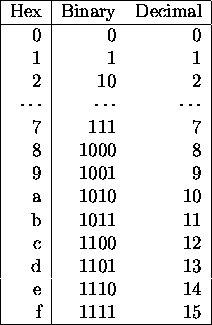 .
.
Radix point.

We can substitute any radix and digit set we want.
Tom Kelliher, CS 220
Aug. 31, 2001
Read 1.3 of Mano.
Base conversion and character representation.
Why are computers digital?
What number system do they use?
How do we represent 0 and 1? Voltage.
Logic levels for SN7400 5 V part (see class home page for data sheet):
Example: 7400 two-input NAND gate waveform. Note voltage vs. time.
Why is digital logic binary?
Positional, weighted number systems. Example of a non-weighted number system: Roman numerals. Example of non-positional non-weighted number system: unary.
Radix, digit set.
 .
.
Radix point.

We can substitute any radix and digit set we want.
 ,
,  , and
, and  ?
?
Binary point
(Octal is similar --- study on your own.)
How? --- Powers of two.
0XFE23, 0x89ab. (0567).

 .
.
Meaning of unsigned.
Convert the following binary numbers to hexadecimal and decimal: